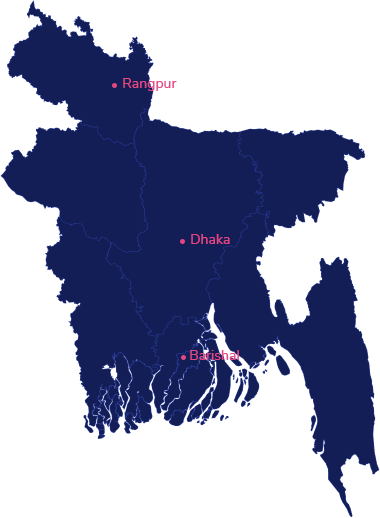In Bangladesh, women and girls face barriers to employment. There are significant differences between women’s and girls’ formal labour participation and men’s and boys’ participation in Bangladesh: only 37.7% of women and girls participate in the formal labour force, compared to 80.6% of men and boys. Women and girls in Bangladesh are also more likely than men and boys to be in vulnerable employment, which is characterised as “outside of formal work arrangements, social protection, and safety nets to guard against economic shocks” (The World Bank, Gender data portal).

For many women and girls in Bangladesh, early marriage is a reality, with 51% married by age 18. Women and girls who marry early face more barriers to completing their education and participating in the formal labour market. Early marriage can negatively affect economic potential. It is estimated that Bangladeshi women and girls who marry early experience a 12% loss in earnings and productivity. Men and boys tend to marry later; only 4% are married by age 18 (Girls Not Brides, Child marriage atlas — Bangladesh).
Bangladesh has made large strides in closing the gender gap in education for women and girls: they now have higher completion rates for primary and lower-secondary education than men and boys. One influencing factor in this context has been the prevalence of garment industry jobs that require employees to have a basic education. However, upper-secondary completion rates are low for both groups, with women and girls having slightly lower completion rates than men and boys.
Women and girls still face barriers to education, as they often participate in household labour and income-generating activities during the school term, which can force them to drop out of school. Early marriage is also a major reason for women and girls dropping out of school (The World Bank, How to provide opportunities for all? From girls’ education to women’s labour force participation in Bangladesh).
Bangladesh is extremely vulnerable to climate change and climate-related disasters. It regularly experiences cyclones, flash floods and drought. Due to differences in access to resources, assets and decision-making processes, women and girls are disproportionately affected by climate change and fallout from climate events (Notre Dame Global Adaptation Initiative, Bangladesh).
Cyclones and storm surges are occurring in Bangladesh with greater frequency because of climate change. Women and girls are more vulnerable to the consequences of cyclones and storms, as they are more likely to have limited access to early warning information and technology. Disaster shelters are not designed for the needs of different genders, which can discourage women and girls from using them. Women and girls are heavily impacted by stretched medical services and food and water insecurity in the aftermath of a disaster (UN Women, State of Gender Equality and Climate Change in Bangladesh).
During monsoons and times of significant rainfall, agricultural land can become waterlogged. Changes in water levels, particularly salt water, can lead to high salinity in agricultural land. Waterlogging and high salinity can disrupt household work, create food insecurity and make it difficult to collect drinking water and fuel, lead to a lack of sanitation and reduce road accessibility to schools — and all these challenges disproportionately affect women and girls (UN Women, State of Gender Equality and Climate Change in Bangladesh).
Floods and flash floods are a recurring reality in Bangladesh, and the ensuing disaster conditions impact women and girls in particular. Flooding can result in forced migration for women and girls, as well as loss of crops, food insecurity, and difficulties collecting drinking water and fuel. At the other end of the weather scale, temperature and climate change have caused drought conditions in some areas of the country. Drought contributes to food insecurity and malnutrition, leaving women and girls vulnerable to gender-based food distribution. Lack of drinking water heavily impacts household workloads and health. Drought can cause women and girls to migrate, which can force them to drop out of school and increase their risk of being trafficked (UN Women, State of Gender Equality and Climate Change in Bangladesh).
In Bangladesh, it is estimated that 6.94% of the population had one or more visible or non-visible disabilities in 2016. Data on disabilities are imperfect, but the national census data suggest that “there are more persons with disabilities in rural than urban areas and physical and visual impairments are the most common disabilities.” There is a wide range of women and girls with physical and mental disabilities, all of whom have unique needs (UNICEF, Disability-Inclusive Education Practices in Bangladesh).
Access to education and educational services and support for people with disabilities is still lacking. Education rates for women and girls with disabilities are much lower than education rates among the general female population (UNICEF, Disability-Inclusive Education Practices in Bangladesh). Barriers to education include lack of financial resources, lack of parental support, inability to access school due to distance and cognitive barriers to learning. Access to educational programmes that support people with disabilities is a challenge for women and girls living in rural locations as such programmes are often limited to urban areas.
Persons with disabilities, and particularly women and girls, also face barriers to securing employment. Barriers to employment include a lack of accessible work opportunities, lack of support from family and community and lack of skills (SARPV, Report on Women with Disabilities in Bangladesh).
Stigma around disabilities persists in some families and communities. Most communities do not have the infrastructure — for example, ramps — to support people whose mobility is impaired. Individuals who need ongoing support for their health often rely on immediate family members, neighbours or household help for care. As well, many learning institutions do not have the required infrastructure — for example, ramps or accessible toilets — to support women and girls with disabilities (SARPV, Report on Women with Disabilities in Bangladesh).